Love them or hate them, you cannot deny the beauty of intricately crafted milkweed blooms, often deliciously perfumed and beloved by butterflies. Some Asclepias are well known invasive weeds, many are course stalwart plants more suited to a wild prairie garden, and relatively few may gain admittance to a rock garden. The North American west holds a number of fascinating dwarf Asclepias species, most will be challenging to cultivate. Let me start with one of the most remarkable dwarf milkweeds, the rare Asclepias uncialis, or Dwarf Milkweed (to that common name it holds more than true). There are two subspecies; ssp. uncialis, and ssp. ruthiae.
http://plants.usda.gov/java/profile?symbol=ASUNU2
...ssp. uncialis flower close-up
http://calphotos.berkeley.edu/cgi/img_query?enlarge=0000+0000+0504+0481
...ssp. ruthiae plant out of flower
http://plants.usda.gov/java/largeImage?imageID=asunr_001_ahp.tif
I found the following document, Rare Plant Surveys on Fort Carson 2006-2007, Colorado State Univ., 70 pages, 5.5 MB PDF, with information on Asclepias uncialis ssp. uncialis with two good photographs. Since the large multi-megabyte PDF download might be too slow for some viewers, under the fair use provision I include two screen captures (above) from the document showing this rare and extraordinary minuscule plant, small enough for a trough if it could be cultivated. The coins give a good sense about how tiny the plant is.
http://www.cnhp.colostate.edu/download/documents/2007/FtCarson_FINAL1221...
Comments
Re: Armchair botanizing for Extreme Milkweeds (Asclepias)
Some years ago I tried a couple of milkweed but they never survived.
Now I think I have to try A uncialis.
Mark, all the plants you present give me much pleasure but also much work ;)
Re: Armchair botanizing for Extreme Milkweeds (Asclepias)
I love every milkweed, I think! None in my region... This tiny species is exquisite for sure, I've been drooling over several in Alplains catalogue for a while; Gardens North has some nice ones too, but of the larger sorts..
Re: Armchair botanizing for Extreme Milkweeds (Asclepias)
About 6 years ago I germinated some Asclepias asperula seeds from Alan Bradshaw's Alplains, and I have managed to keep two alive and blooming. 2 years ago one of the plants bloomed spectacularly, and for 3 weeks it was covered with ants, various beetles and a very few butterflies. After some research I discovered that this plant provides migrating monarch butterflies their primary source of nectar as they migrate through Texas, where 'Antelope Horns' are most commonly found. My daughter took several pictures, and the one I've linked is by far the best. It's a lovely plant, spreading to about 1 foot and each year I've gotten between 2 and 6 flowers. And since the first year, when 4 simply didn't come back, the two I've still got have reliably showed up sometime in mid to late April, blooming in mid to late May.
Re: Armchair botanizing for Extreme Milkweeds (Asclepias)
Gorgeous thing, Peter. Many thanks for posting.
Re: Armchair botanizing for Extreme Milkweeds (Asclepias)
Some years ago I tried a couple of milkweed but they never survived.
Nice plants! Would love to grow more - have tried and failed with many over the years - A. purpurascens, quadrifolia, tuberosa, rubra, syriaca, incarnata (several cultivars). However, I have one which I've had for over 10 years - I received it as syriaca, but I decided at one stage that it was incarnata, but I'm not sure (any suggestions). The season's too short for seed to mature though...
Re: Armchair botanizing for Extreme Milkweeds (Asclepias)
Peter, I like your Asclepias asperula! But it being a Texan, do you think I could grow it?
Stephen, if you can grow Asclepias it is hope for me too ;D
Re: Armchair botanizing for Extreme Milkweeds (Asclepias)
Trond, it's hard to say. I have it growing in almost pure gravel, facing southwest. It needs a lot of sun during its growing season, which is really from early May through late August. It tends to go dormant around Sept 1 each year. If you have a spot that gets sun during the summer on a fairly consistent basis, the wetness shouldn't bother it. It might be worth a try. Just make sure you give it a lot of gravelly mix, with virtually no soil for 6 inches deep and 1 foot around. I haven't seen it show itself yet this year, which was the snowiest of the past decade or two. Last year we had a couple of January/February thaws, and yet it still did fine. Honestly, I think you ought to give it a try. It's easy to germinate too.
Re: Armchair botanizing for Extreme Milkweeds (Asclepias)
OK, Peter, thanks!
I'll try it at my summerhouse too. There the climate is better - drier and warmer! In fact I need some summer flowering drought tolerant plants there - and if they attract butterflies that is a big bonus!
Re: Armchair botanizing for Extreme Milkweeds (Asclepias)
Like Stephen I've tried quite a few Asclepias from seed but haven't managed to keep them to flowering. They are completely fascinating plants with extraordinary flowers. The larger species do well; speciosa is very good with greyish foliage; syraica is really too much of a good thing, spreading rapidly underground and with rather squinney flowers, tuberosa has been glorious but not persisted. Having seen pictures of the more choice and small western species I shall persevere with trying them in deep gravel as and when seed is available. Meantime I will enjoy the photos!
Re: Armchair botanizing for Extreme Milkweeds (Asclepias)
Butterfly weed (Asclepias tuberosa) started easily from seed for me. The little sausage of a root they produce in just a couple months is fascinating. With all that stored energy, I don't know why they are so finicky about transplanting, but they certainly are.
The seedling on the right is Lead Plant (Amorpha canescens), with its long, horseradish-like root.
Re: Armchair botanizing for Extreme Milkweeds (Asclepias)
Butterfly weed (Asclepias tuberosa) started easily from seed for me. The little sausage of a root they produce in just a couple months is fascinating. With all that stored energy, I don't know why they are so finicky about transplanting, but they certainly are.
Rick,
Are they fincky if you plant a potfull without disturbing the roots at all? Do other milkweeds behave in the same way?
Re: Armchair botanizing for Extreme Milkweeds (Asclepias)
I have some (A. tuberosa) growing in pure sand and they are doing well. They are native here but only found in sandy areas. The roots are very brittle and very susceptible to rot which is probably why they are hard to transplant. Give the pure sand (at least 10" of it) a try. I'd be interested to hear if it does the trick.
Regarding Butterfly weed, Trond, transplanting with a large soil ball intact would be a logical assumption, but I have no experience. If you plant in sand, I might expect the sand to fall away from the roots anyway. Maybe it would be better to seed in a a pot that will decompose so, the whole thing can be transplanted, or seed in a pot where you can remove or cut the bottom off when it's time to transplant.
Asclepias tuberosa is native here in the Midwest (USA) also. They do mostly grow in sandy prairie habitat, but I have noticed them in dry clay based soil, too. I think my climate is drier than Lis's and may account for the difference. Or, I wonder if sand is just were they compete best, rather than a need.
Re: Armchair botanizing for Extreme Milkweeds (Asclepias)
When I get the chance I'll try some of these "Extreme Milkweeds"! No problem getting sand ;D clay is difficult to find here.
Re: Armchair botanizing for Extreme Milkweeds (Asclepias)
Trond, if only we were close enough to do a swap..... no sand here at all, nor gravel (there are random deposits in the area, but all on private land, and not ours!)... I'll have to buy some :(
Re: Armchair botanizing for Extreme Milkweeds (Asclepias)
Trond, if only we were close enough to do a swap..... no sand here at all, nor gravel (there are random deposits in the area, but all on private land, and not ours!)... I'll have to buy some :(
Should be cheaper to buy than mail some ;D
Re: Armchair botanizing for Extreme Milkweeds (Asclepias)
Trond, if only we were close enough to do a swap..... no sand here at all, nor gravel (there are random deposits in the area, but all on private land, and not ours!)... I'll have to buy some :(
Should be cheaper to buy than mail some ;D
Lol--Yes, not sure about your mail rates, and I have not yet checked truckload prices for gravel, but I suspect it would not be a very large package of soil/sand here that would cost as much to mail as a truckload locally...lol--
my problem is they will probably have to drive at least 60km round trip, and I am going to have to pay for that time/mileage...
Re: Armchair botanizing for Extreme Milkweeds (Asclepias)
Came across some good photos of two more western American milkweeds:
Asclepias asperula:
http://www.swcoloradowildflowers.com/Brown%20Green%20Enlarged%20Photo%20...
Asclepias involucrata (syn: macrosperma), notice in the first link the compact A. tuberosa only growing 17-18" tall:
http://www.swcoloradowildflowers.com/Yellow%20Enlarged%20Photo%20Pages/a...
http://plants.usda.gov/java/largeImage?imageID=asin14_001_ahp.tif
...large image:
http://plants.usda.gov/gallery/pubs/asin14_002_pvp.jpg
...dwarf white-flowered plant image from CalPhotos, taken in New Mexico:
http://calphotos.berkeley.edu/cgi/img_query?enlarge=0000+0000+0604+0305
http://calphotos.berkeley.edu/cgi/img_query?enlarge=0000+0000+0604+0306
Re: Armchair botanizing for Extreme Milkweeds (Asclepias)
Those are exotic beauties, Mark. I've never found the more moisture-loving native species to do very well for me, so perhaps these more dryland species might be worth a try.
Re: Armchair botanizing for Extreme Milkweeds (Asclepias)
I've wanted to grow some of these more choice asclepias for years without too much success. But after a few years wait I have at last got flowers on A. vestita and the combination of woolly foliage and those extraordinary pink and yellowish flowers is amazing! I shall now definitely persevere with some of the smaller species - I have viridis and asperula on a raised bed, and will do a little more armchair botanising to follow Mark's example and learn more of these plants.
Re: Armchair botanizing for Extreme Milkweeds (Asclepias)
I am jealous, Tim! The only "Asclepias" I grow is a weed, it isn't even a real milkweed (Vincetoxicum rossicum) - and the slugs don't like it either :-\
Re: Armchair botanizing for Extreme Milkweeds (Asclepias)
Way cool extreme milkweed there Tim! Congratulations. I really want to grow some of these. Let us know if the flowers are fragrant, so many Asclepias species are richly perfumed.
Next weekend I'll be vacationing for my 32nd wedding anniversary at a B&B (Bed & Breakfast) in central Vermont, and last time I was there many years ago, there alongside a river's edge were lots of A. virticllata in fine bloom, a smallish elegant species with refined linear foliage like that of Amsonia hubrectii or A. lettermanii and crisp white flowers, to see it is to want it. I will have to remember to pack a trowel ;)
http://calphotos.berkeley.edu/cgi/img_query?query_src=photos_index&where...
http://www.wildflower.org/gallery/result.php?id_image=30910
http://www.wildflower.org/gallery/result.php?id_image=31487
...look at this seed catalog page, and the awesome upright pods in the last image (click the "Images" tab)
http://www.prairiemoon.com/seeds/wildflowers-forbs/asclepias-verticillat...
Re: Armchair botanizing for Extreme Milkweeds (Asclepias)
Tim, does the wool mean it is not a moisture lover? ???
Re: Armchair botanizing for Extreme Milkweeds (Asclepias)
That is a delicate beauty Mark, and makes me want to try these plants even more. And yes, A.vestita is nicely scented up close - I hadn't noticed until your comment. My wife is a good artist and these would make beautiful subjects.
Trond - I've seen a Vincetoxicum species at Wisley in the autumn with superb autumn colour. I can imagine the slugs would leave these plants alone with their milky sap.
Rick - we are growing it in relatively dry sandy soil in a south facing border next to the greenhouse. I've assumed it is not a moisture lover (compared to some of the more vigorous species that are), but we also grow speciosa, again very woolly foliage, but I seem to remember reading somewhere that this does prefer more moisture? I do need to learn more about them in the wild and presumably verticillata, for example, does grow in damper soil?
Re: Armchair botanizing for Extreme Milkweeds (Asclepias)
All beauties, Mark and tim- I don't think I've seen a milkweed I didn't like :) Alplains has quite a few dryland forms available, I've yet to try, but they are on my 'list' as are some more woodland/edge types Kristl sells.. remains to be seen whether my moist or drier areas will be more effective..
None of the native ones make it to my area that I've seen..
happy anniversary, Mark!
Re: Armchair botanizing for Extreme Milkweeds (Asclepias)
Thanks Cohan.
Regarding milkweeds (Asclepias) one has to be careful with some species, such as Asclepias syriaca found through much of North America except the Western States and Canadian Provinces, a plant that is considered weedy or invasive. Some species can spread by long underground rhizome, and to eradicate the plant, it requires pulling the incessant sprouting shoots at first sign, for a good number of years until the rhizomes give up.
Asclepias syriacus is abundant here; I like having the plant at the fringes of the yard for the attractive flower globes, intricate florets, and incredibly sweet fragrance, but NEVER EVER let a seedling take hold in the garden, as it will take years of constant pulling of shoots to weaken the perennating rhizomes. I doubt there is need of similar caution on the many choice Western American dryland species.
Re: Armchair botanizing for Extreme Milkweeds (Asclepias)
I presume syriaca is the species I saw regularly as a 'wild' plant in downtown Toronto, it was a great fave of mine, and I wouldn't even mind having to pull out excess plants :)
A speciosa and ovalifolia both occur in Alberta, though just outside my area, but not by that much... A viridiflora is only reported in the extreme south of the province...
Re: Armchair botanizing for Extreme Milkweeds (Asclepias)
In Minnesota, this photo shows the thickest stand of Common milkweed (Asclepias syriaca) I've seen in the true wild. But where humans have disturbed the environment, it can grow very thickly. That would include roadsides. I also have seen it grow rather exclusively in the U of Wisconsin arboretum prairie, which is mostly man made, but I think something like 40 years invested in the restoration. I am not sure what the deal is there. It could very well be that the species is adapted to other climates better than in Minnesota.
Re: Armchair botanizing for Extreme Milkweeds (Asclepias)
Sadly I planted syraica about about 20 years before Mark's advice! It does spread but our dry climate probably keeps it reasonably under control - in a wilder setting like Rick shows it is very nice to see. I've tried to establish tuberosa several times thinking it would be well suited to our climate, but plants always die out after a few years. There are some good colour variants of this in horticulture though, and maybe more adaptable plants might arise in time - unusually vivid for an asclepias.
Re: Armchair botanizing for Extreme Milkweeds (Asclepias)
Here is Asclepias syriaca with an eastern tiger swallowtail feeding on it we saw in early July at the Ontario Botanic Gardens. This was a dry area but we saw quite a bit of it growing in the wild in the damp areas.
Re: Armchair botanizing for Extreme Milkweeds (Asclepias)
Nice photos Rick and Tony :) At my last apt in Toronto, I had one small flower bed in front of my front window, maybe 4x6 or 8 feet; I grew a few things in there, nothing easily stolen or expensive, since it was right on the sidewalk, right downtown, and vulnerable to humans and their danged pets (why do so many dog owners think the world is their toilet?). but there was a pre-existing yucca that flowered spectacularly, and a probably self sown patch of milkweed- it was spreading, but wasn't yet a problem..
Re: Armchair botanizing for Extreme Milkweeds (Asclepias)
Asclepias variegata seems to be scarcely in cultivation. Anyone growing this. Seneca Hills did offer, but mine died.
Charles Swanson z6A MA NE USA



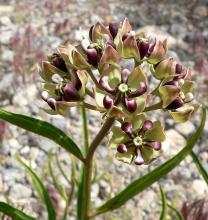
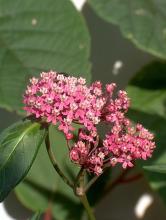
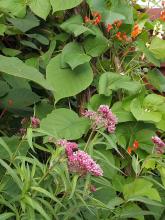
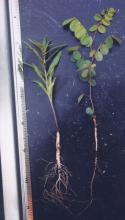
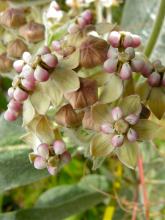
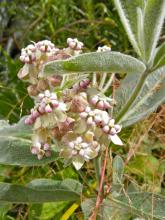
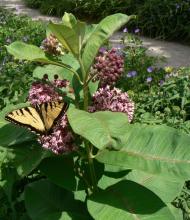
The US Forest Service has a very good page on Asclepias uncialis ssp. uncialis (Dwarf Milkweed, Circle Milkweed).
http://www.fs.fed.us/wildflowers/plant-of-the-week/asclepias_uncialis.shtml
Their photo of this plant is by far the best I've found, what pure milkweed delight.
http://www.fs.fed.us/wildflowers/plant-of-the-week/images/wheelmilkweed/...
Excellent US Forest Service document on Asclepias uncialis ssp. uncialis, PDF, 2.5 MB.
http://www.fs.fed.us/r2/projects/scp/assessments/asclepiasuncialis.pdf